

WEEK 44: OCTOBER 25-31
TOPIC: KREUTZ SUNGRAZERS
The Great Comet of 1882 – a recent previous “Comet of the Week” – attracted a lot of attention from around the world from both astronomers and the lay public. One of the many interesting facets of this comet had been its very small perihelion distance, just a few hundred thousand km above the solar photosphere. It so happened that 2½ years earlier, i.e., in February 1880, a somewhat dimmer comet – about 3rd magnitude, although with a tail 50 to 60 degrees long – had briefly been observed from the southern hemisphere, and this comet’s orbit bore a striking resemblance to that of the Great Comet of 1882. One person in particular who noticed this was the German astronomer Heinrich Kreutz, who noted that the Great Comet of 1843 – another previous “Comet of the Week” – also traveled in a very similar orbit. Since the calculated orbital periods were in the neighborhood of several centuries it was clear that these could not be returns of the same comet, and Kreutz soon speculated that they were instead returning fragments of a larger comet that had split up during a previous return. Since the Great Comet of 1882 had split into at least four separate fragments as it passed through perihelion such an occurrence would seem highly plausible.
The appearance of another comet with a similar orbit in January 1887 reinforced Kreutz’s ideas in this matter. (This particular comet, which was visible only from the southern hemisphere, is unusual in that it never exhibited anything in the way of an actual “head;” instead, it appeared as a long straight tail that reached a maximum length of 35 to 40 degrees, and it is often referred to as the “headless wonder.”) Kreutz also speculated that Comet Tewfik (new style designation X/1882 K1), which had appeared only during the total solar eclipse on May 17, 1882 – and which is another previous “Comet of the Week” – was another member of this comet group. In an attempt to identify a possible progenitor comet of these “sungrazing” comets, Kreutz proposed that a brilliant comet observed throughout the world in February and March 1106 (new style designation X/1106 C1) could be a potential candidate. The positional information about this comet is not good enough to permit the calculation of a reliable orbit, however the general description of its motion and appearance – including daylight visibility close to the sun in early February, when it was presumably near perihelion – is reasonably consistent with such an idea.
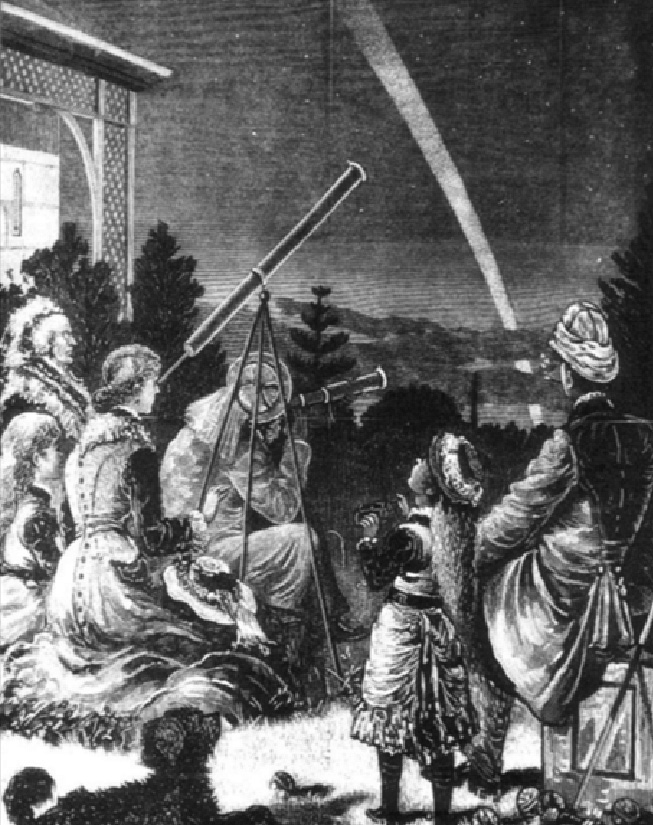
Kreutz sungrazing comets that appeared around the time of the Great Comet of 1882. Left: Observers following the Great Southern Comet of 1880, ostensibly on February 14, 1880. Courtesy State Library of Victoria. Right: Motion and tail development of the “headless wonder” Comet of 1887. From “Knowledge” by Richard Proctor.
Meanwhile, there have been efforts to identify previous members of the Kreutz sungrazing group, although these efforts are hampered by the fact that the positional information in earlier centuries is often not good enough to allow for the determination of reliable orbits. The Great
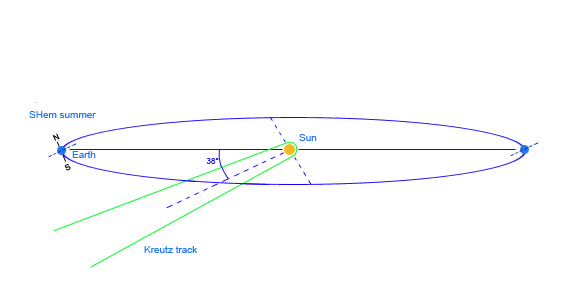
Three Kreutz sungrazers appeared during a span of seven years beginning in the mid-1960s. The first of these was Comet Pereyra 1963e, discovered in September 1963, which initially was 5th or 6th magnitude with a pale, ghostly tail – described by some observers as a “searchlight beam” – about ten degrees long, and which faded away relatively quickly. Two years later, Comet Ikeya-Seki 1965f, the 20th Century’s brightest comet and this week’s “Comet of the Week,” appeared. Finally, Comet White-Ortiz-Bolelli 1970f was as bright as 1st magnitude when it was discovered shortly after mid-May 1970, and for a while exhibited a bright tail up to 15 degrees long, but like some of the other Kreutz sungrazers it faded away rather quickly.
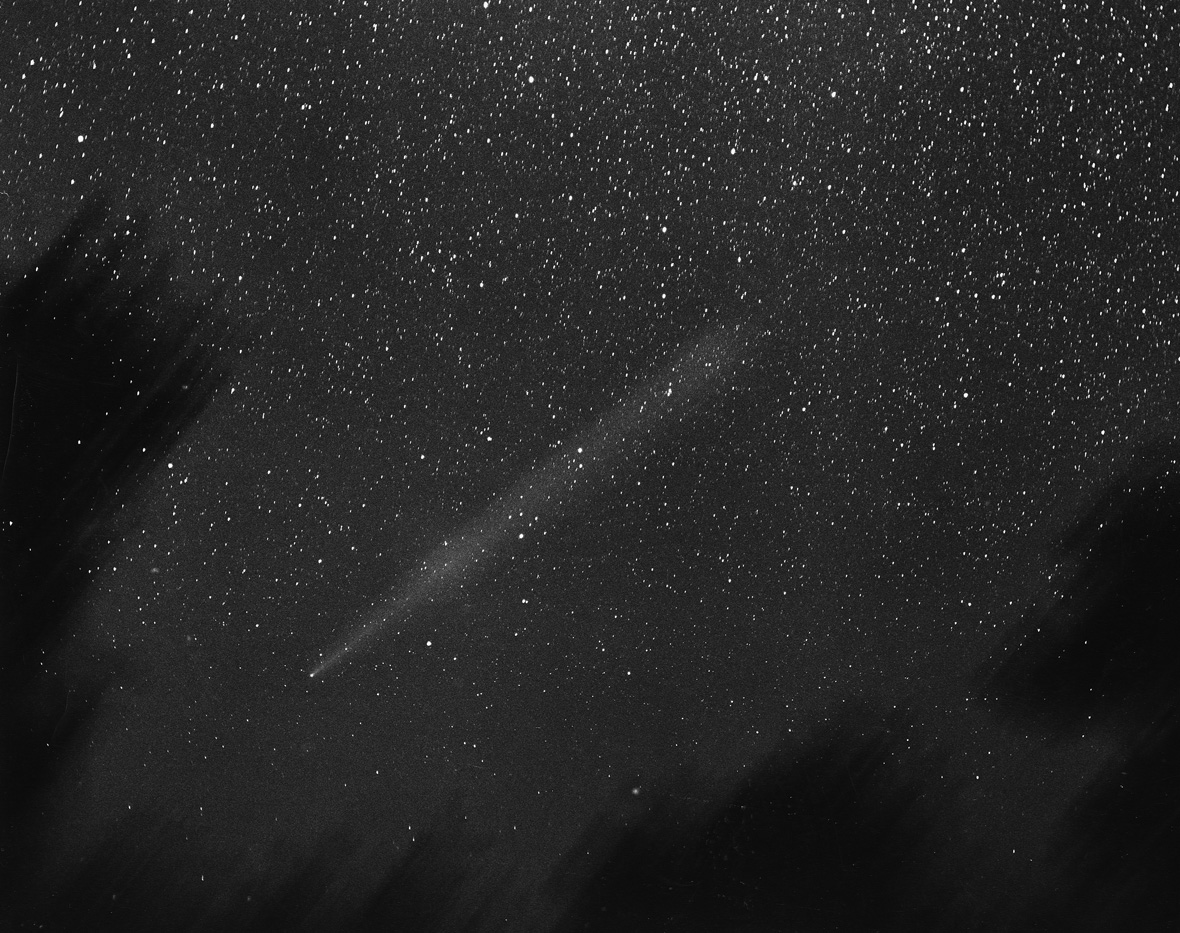
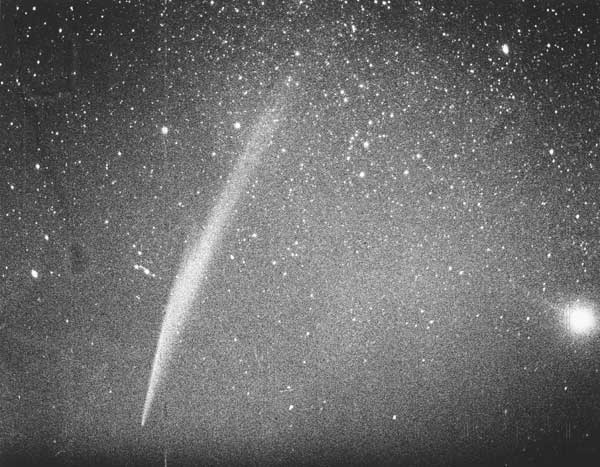 Kreutz sungrazing comets that appeared around the time of Comet Ikeya-Seki in 1965. Left: Comet Pereyra 1963e, as photographed from north of Los Angeles by Alan McClure on September 21, 1963. Photo copyright Alan McClure. Right: Comet White-Ortiz-Bolelli 1970f (and Venus) on May 23, 1970, from the European Southern Observatory in Chile. Courtesy Hans Michael Maitzen, Anthony Moffat, and Hans-Emil Schuster.
Kreutz sungrazing comets that appeared around the time of Comet Ikeya-Seki in 1965. Left: Comet Pereyra 1963e, as photographed from north of Los Angeles by Alan McClure on September 21, 1963. Photo copyright Alan McClure. Right: Comet White-Ortiz-Bolelli 1970f (and Venus) on May 23, 1970, from the European Southern Observatory in Chile. Courtesy Hans Michael Maitzen, Anthony Moffat, and Hans-Emil Schuster.
Around the time of these comets’ appearances, the evolution of Kreutz sungrazers as a whole was thoroughly investigated by Brian Marsden, who served as Director of the IAU’s Central Bureau for Astronomical Telegrams and the Minor Planet Center for several decades. Marsden noted that there were some differences in the orbital elements of the respective comets, and concluded that they came in two distinct “groups,” which he named “Subgroup I” and “Subgroup II.” Subgroup I included the comets of 1843 and 1880 as well as Comet Pereyra in 1963, whereas Subgroup II included the Great Comet of 1882 and Comet Ikeya-Seki in 1965 (and also probably Comet du Toit in 1945). (Comet White-Ortiz-Bolelli in 1970 is somewhat similar to the Subgroup II comets but different enough that Marsden placed it in its own category, “Subgroup IIa.”) Marsden concluded that the Great Comet of 1882 and Comet Ikeya-Seki probably split from each other at a previous return, which based upon their respective orbits would have been sometime during the early 12th Century – consistent with the bright comet of 1106. The Subgroup I comets would have originated from another comet that would have appeared sometime within a few centuries of the 1106 comet, and these two perhaps split from each other during a previous return. All the Kreutz sungrazers likely originated from one single comet that appeared sometime in the distant past, which split into fragments, with each of these fragments subsequently undergoing their own fragmenting events during subsequent returns.
The discovery of Comet SOLWIND 1 – yet another previous “Comet of the Week” – by the U.S. Defense Department satellite P78-1 in 1979 added a fresh new wrinkle to this phenomenon once it was shown to be a Kreutz sungrazer. The subsequent discovery of several additional Kreutz sungrazers by P78-1 over the next few years, and then ten additional such objects by NASA’s Solar Maximum Mission (SMM) satellite during the mid- to late 1980s, demonstrated that there was an entire population of these comets the existence of which we were quite unaware. (Upon examining their respective orbits, Marsden determined that these were all members of Subgroup I.) With the launch of the joint NASA/ESA SOlar and Heliospheric Observatory (SOHO) spacecraft in late 1995 the discovery of even smaller Kreutz sungrazing comets almost exploded, with almost 3500 having now been detected, as well as over 110 more that have been found by the later twin spacecraft of NASA’s Solar and TErrestrial RElations Observatory (STEREO) mission.
While some of the SOHO Kreutz sungrazers are relatively bright in the coronagraph images, such as the “twin” Comets C/1998 K10 and C/1998 K11 that collectively constitute a previous “Comet of the Week,” most of them are quite dim, some being no brighter than 8th or 9th magnitude despite their proximity to the sun. They accordingly must be very tiny objects, the nuclei of even the largest probably being no larger than a few meters in diameter. Marsden pointed out that even when some of these objects arrived just a few hours apart they sometimes were in different Subgroups, thus indicating that the formation of these comets is almost a continuous process. At a small enough level, these comets might almost constitute a “Kreutz meteor stream” raining down onto the sun.
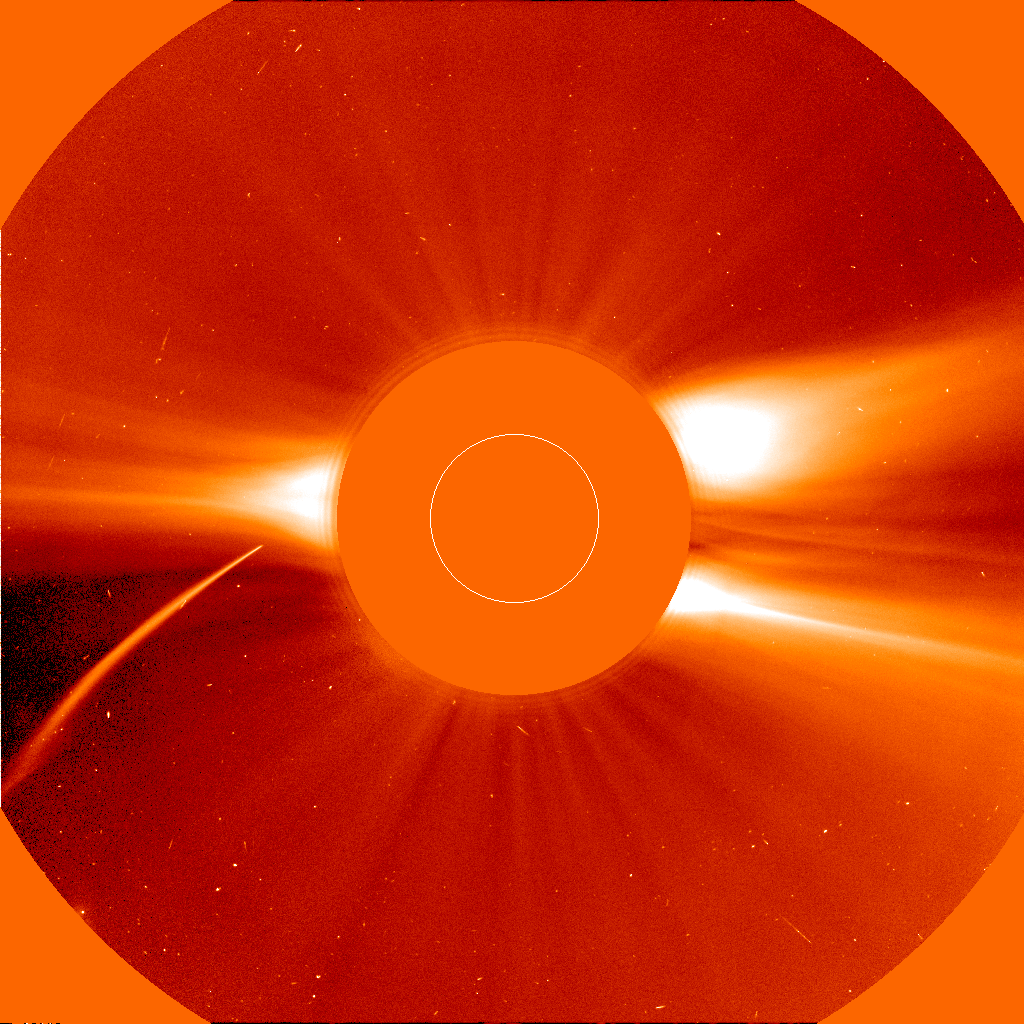
 Kreutz sungrazers in the LASCO C2 coronagraph aboard the SOlar and Heliospheric Observatory (SOHO) spacecraft. Left: The first bright SOHO sungrazer, C/1996 Y1, on December 23, 1996. Right: An as-yet-undesignated Kreutz sungrazer that appeared last week; image taken October 22, 2020. Both images courtesy NASA/ESA.
Kreutz sungrazers in the LASCO C2 coronagraph aboard the SOlar and Heliospheric Observatory (SOHO) spacecraft. Left: The first bright SOHO sungrazer, C/1996 Y1, on December 23, 1996. Right: An as-yet-undesignated Kreutz sungrazer that appeared last week; image taken October 22, 2020. Both images courtesy NASA/ESA.
Zdenek Sekanina and Paul Chodas at NASA’s Jet Propulsion Laboratory undertook a detailed re-examination of the Kreutz sungrazers’ orbital evolution during the mid-2000s, utilizing both historical data as well as data on the spacecraft-discovered Kreutz comets up until that time. While the Great Comet of 1882 and Comet Ikeya-Seki had both undergone distinct fragmentation events at their respective perihelion passages – and presumably other Kreutz sungrazers have done so as well – Sekanina and Chodas argue that additional fragmenting may have occurred much farther away from the sun, even around aphelion. (There is distinct circumstantial evidence that this has happened with other comets.) In this context, the Subgroups are not as important as might appear to be at face value, and in fact comets formed from the same fragmenting event may actually migrate from one Subgroup to another.
Sekanina and Chodas point out that the bright Kreutz sungrazers have often arrived in “clusters” where several of them appear over a short period of time. Once such “cluster” seems to have occurred during the late 17th Century, and one definitely occurred during the 1880s with another one in the 1960s. In this scenario the various comets within a given cluster all result from the same fragmenting event that would have taken place at a large heliocentric distance, and the appearances of comets from different Subgroups within any given “cluster” is thus not a coincidence.
In terms of the overall evolutionary picture, Sekanina and Chodas suggest that, while the Great Comet of 1882 and Comet Ikeya-Seki did have a common progenitor comet, that object may not have been the comet of 1106 but instead another comet that appeared within the same general timeframe but for whatever reason – perhaps because it came at a time of the year when Kreutz sungrazers are under poor viewing geometry – was not recorded. That comet, and the 1106 comet, were in turn the returning fragments of a comet that had split previously; possible candidates for this object are comets that appeared in February 423 and February 467. As for the original progenitor comet, there has often been speculation that this might have been a brilliant comet that appeared in 372 B.C., however all the information about this comet seems to be second-hand, and thus it is difficult at best to establish any kind of meaningful connection. Sekanina and Chodas propose that a comet observed from China in 214 B.C. may possibly be the Kreutz progenitor comet.
Meanwhile, in a 2007 paper Sekanina and Chodas made the prediction that, based upon their overall analysis, another “cluster” of bright Kreutz sungrazing comets was on its way into the inner solar system and, in their words, “is expected to arrive in the coming decades, its earliest member possibly just several years from now.” Less than 4½ years later, what may very well have been this “earliest member” appeared, Comet Lovejoy C/2011 W3. This is a future “Comet of the Week,” and I will continue the story of the Kreutz sungrazers in that Presentation.
“Special Topics” archive
Ice and Stone 2020 home page
Earthrise Institute home page